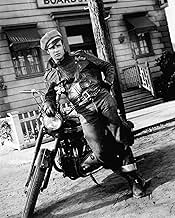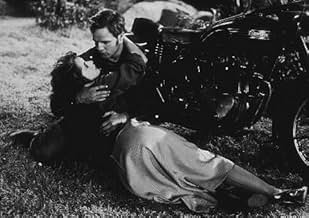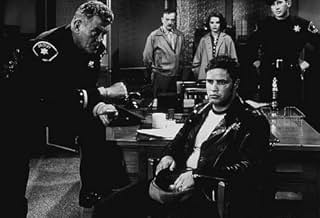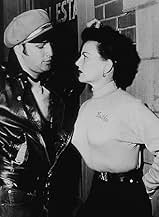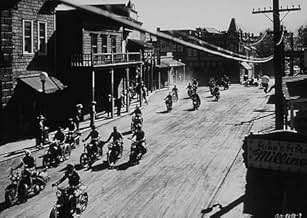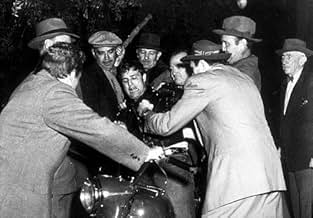IMDb RATING
6.7/10
19K
YOUR RATING
Two rival motorcycle gangs terrorize a small town after one of their leaders is thrown in jail.Two rival motorcycle gangs terrorize a small town after one of their leaders is thrown in jail.Two rival motorcycle gangs terrorize a small town after one of their leaders is thrown in jail.
- Director
- Writers
- Stars
Wally Albright
- Cyclist
- (uncredited)
Chris Alcaide
- Deputy
- (uncredited)
Don Anderson
- Stinger
- (uncredited)
Robert Bice
- Wilson
- (uncredited)
- Director
- Writers
- All cast & crew
- Production, box office & more at IMDbPro
Featured reviews
A peaceable town is taken over by motorcycle rowdies.
Despite the sometimes frat boy antics of gang members, the movie came across to audiences of the time as something of a 50's nightmare. For example, there's a small town taken over by motorcycle outlaws, a virginal girl (Murphy) surrounded by rowdies, a cop too meek to intervene, and a general breakdown of peace, quiet and conformity. In short, it's a challenge to the every day norms the famously inarticulate Johnny (Brando) is rebelling against. It's that sort of restlessness that takes the gang to the highway, and the excitement they seek. But it's also a nation recovering from the rigors of a big Depression and the disruptions of WWII. So the two are bound to clash. The movie may seem tame by today's graphic standards, but for the 1950's it was a barbarian assault against the decade's defining conventions. No wonder, the film was condemned in so many places.
Truth be told, Brando doesn't act so much as he poses. Nonetheless, it's an iconic pose in cap and sunglasses that shot him to the forefront of the decade's celebrated rebels. For example, catch how delicately he positions the sunglasses or how he slouches silently by while others cavort. Still, the movie really comes alive when Lee Marvin (Chino) and his gang hit town. He's the loudmouth opposite of Johnny, looking to knock him off his regal pose, which he tries in a well-staged fistfight. Then there's Mary Murphy's good girl, a perfect casting choice. When she flees down a darkened street just ahead of the motorcycle rowdies, I could feel frozen shudders all over the theater of that day. It was like small town America about to be ravaged. Of course, the tables are turned when some of the town's bolder elements form into vigilantes and chase Johnny down the same street. I guess violence, as they say, really is a two-way street.
Anyway, the movie's still a milestone worth catching up with. My only gripe is with the cheapness of the production. The town and the sets are bare bones, especially in the movie's latter half. Maybe that was intentional in order to highlight the story. But if so, it came at the expense of a realistic undercurrent, especially the atrocious exterior set for Johnny and Kathie's little get-away, appearing more like a stage play than a film. All in all, it's a signature movie for the young Brando, cementing his rebel image for a generation.
Despite the sometimes frat boy antics of gang members, the movie came across to audiences of the time as something of a 50's nightmare. For example, there's a small town taken over by motorcycle outlaws, a virginal girl (Murphy) surrounded by rowdies, a cop too meek to intervene, and a general breakdown of peace, quiet and conformity. In short, it's a challenge to the every day norms the famously inarticulate Johnny (Brando) is rebelling against. It's that sort of restlessness that takes the gang to the highway, and the excitement they seek. But it's also a nation recovering from the rigors of a big Depression and the disruptions of WWII. So the two are bound to clash. The movie may seem tame by today's graphic standards, but for the 1950's it was a barbarian assault against the decade's defining conventions. No wonder, the film was condemned in so many places.
Truth be told, Brando doesn't act so much as he poses. Nonetheless, it's an iconic pose in cap and sunglasses that shot him to the forefront of the decade's celebrated rebels. For example, catch how delicately he positions the sunglasses or how he slouches silently by while others cavort. Still, the movie really comes alive when Lee Marvin (Chino) and his gang hit town. He's the loudmouth opposite of Johnny, looking to knock him off his regal pose, which he tries in a well-staged fistfight. Then there's Mary Murphy's good girl, a perfect casting choice. When she flees down a darkened street just ahead of the motorcycle rowdies, I could feel frozen shudders all over the theater of that day. It was like small town America about to be ravaged. Of course, the tables are turned when some of the town's bolder elements form into vigilantes and chase Johnny down the same street. I guess violence, as they say, really is a two-way street.
Anyway, the movie's still a milestone worth catching up with. My only gripe is with the cheapness of the production. The town and the sets are bare bones, especially in the movie's latter half. Maybe that was intentional in order to highlight the story. But if so, it came at the expense of a realistic undercurrent, especially the atrocious exterior set for Johnny and Kathie's little get-away, appearing more like a stage play than a film. All in all, it's a signature movie for the young Brando, cementing his rebel image for a generation.
Brando is his archetypal mean and moody self, as the original rebel on a motorcycle terrorising smalltown America. The enduring iconic images from the film have weathered better than the film itself, however, but it still stands up as a paean to disaffected youth.
When Johnny and the boys ride into town all hell breaks loose, with a culture clash between themselves and the 'squares', resulting in tragedy and some reconciliation. These boys look tame compared to today's standards (they even pay for their own beer!) but they don't fit in and so are immediately ostracised by a grown-up world that doesn't understand their jive-talking, anti-social behaviour. Johnny's reply when asked, "What are you rebelling against?" says it all..."Whatta you got?", with a sneer for good measure.
Time hasn't been kind to the film, and it's hard to see why it was banned in the UK for 18 years (mainly down to the lack of any retribution for the gang), but there is still a tight story and strong characterisation. It's a pity the film descends needlessly into melodrama, losing much of it's credibility in the process.
When Johnny and the boys ride into town all hell breaks loose, with a culture clash between themselves and the 'squares', resulting in tragedy and some reconciliation. These boys look tame compared to today's standards (they even pay for their own beer!) but they don't fit in and so are immediately ostracised by a grown-up world that doesn't understand their jive-talking, anti-social behaviour. Johnny's reply when asked, "What are you rebelling against?" says it all..."Whatta you got?", with a sneer for good measure.
Time hasn't been kind to the film, and it's hard to see why it was banned in the UK for 18 years (mainly down to the lack of any retribution for the gang), but there is still a tight story and strong characterisation. It's a pity the film descends needlessly into melodrama, losing much of it's credibility in the process.
There's really not much to the story. A motorcycle gang, led by Johnny Strabler (Marlon Brando), roars into a small town and kicks up a ruckus. The older townsfolk don't take kindly to the invasion, and Johnny becomes the object of their wrath. But Johnny is smitten with a young woman who happens to be a cop's daughter. "The Wild One" is a character study of a moody young man who starts out as a juvenile delinquent but changes as the result of a sad, mournful young woman.
Costumes play a big part in this film. Motorcycle gang members wear jeans, T-shirts, motorcycle caps, and heavy leather jackets. That's their uniform, which visually defines their rebellion. Johnny starts out in a leather jacket, and ends up in one. I don't think he ever takes it off through the whole film.
Visuals convey the impression that most of the film was shot on studio back lots. The streets and buildings all look fake. And the cinematography is helped not at all by the use of rear screen projection. Yet, the B&W lighting is quite good, especially in the second half, with high contrast noir lighting.
The film's score is annoying. I could have wished for some early 1950's songs. Plot pacing is poor. And the casting of some of the motorcycle gang is laughable. Some of the "juveniles" appear to be at least 30 or 35 years old.
"The Wild One" is remembered mostly as a cinematic vehicle for Marlon Brando, and because the film was something of a trend setter, in that it helped usher in an era of films about American juvenile delinquents, youthful rebel outcasts who didn't fit in to the post WWII era of middle-America family values.
Costumes play a big part in this film. Motorcycle gang members wear jeans, T-shirts, motorcycle caps, and heavy leather jackets. That's their uniform, which visually defines their rebellion. Johnny starts out in a leather jacket, and ends up in one. I don't think he ever takes it off through the whole film.
Visuals convey the impression that most of the film was shot on studio back lots. The streets and buildings all look fake. And the cinematography is helped not at all by the use of rear screen projection. Yet, the B&W lighting is quite good, especially in the second half, with high contrast noir lighting.
The film's score is annoying. I could have wished for some early 1950's songs. Plot pacing is poor. And the casting of some of the motorcycle gang is laughable. Some of the "juveniles" appear to be at least 30 or 35 years old.
"The Wild One" is remembered mostly as a cinematic vehicle for Marlon Brando, and because the film was something of a trend setter, in that it helped usher in an era of films about American juvenile delinquents, youthful rebel outcasts who didn't fit in to the post WWII era of middle-America family values.
Would this movie still be watched but for Brando's performance? I think not - it would be relegated to the scrap heap of old B movies. But Brando carries the movie by having the right qualities to play Johnny Strabler, the leader of a motorcycle gang that creates havoc in a small California town. Brando plays Johhny with sullen, smoldering rebelliousness with a suggestion of depth and vulnerability underneath. Brando had already shown his abilities in "A Streetcar Named Desire" and was soon to make "On the Waterfront." The performance here is not up to those standards, but it is engaging. At the time he made this movie Brando's star power was such that he could name his roles, so it is interesting to speculate why he chose to make this. Maybe this role appealed to his own rebellious spirit.
The movie is dated for sure, but you may learn some things about the 1950s that you won't find in the history books. Many early 50s anachronisms are in evidence: 78 records on the jukebox, references to television as being new, bebop music and argot, local HUMAN telephone operators. The comment the old bartender makes about the advent of TV is prescient, "Everything is noise and pictures, nobody talks to anyone anymore" - there is more truth to that with each passing decade. The score - generic, loud, obvious, and intrusive - would not be accepted in contemporary movies. Johnny's attempt to be cool by snapping his fingers to music on the jukebox is so phony as to be embarrassing. One interesting thing was to see an early version of the high-five in response to the interjection "pop me." But credit must be given for this being one of the first mainstream movies to treat the rebellion against the claustrophobic conformity and cold war angst of the early 50s. It was unique for its time.
We do not get much motivation for the reasons the gang members behave the way they do. There are mighty few specifics about the guys in the gang - where they come from, how they support themselves, or what they do besides terrorize small towns. We get only a hint of Johnny's past when, during a beating by the locals he says, "My old man used to hit harder than that." But, maybe all we need to know comes from Johnny's extolling the feeling he gets when getting on his cycle to "just go."
There are many memorable scenes, like the one where Johnny is asked if he doesn't want to thank some people who have done him a good deed and he comes to an inarticulate stop only to have his woman friend say, "That's okay, he doesn't know how."
Lee Marvin has a good go playing Chino, the head of a rival gang that had split off from Johnny's. Chino is the more stereotypical bad ass. He may not have the complex personality of Johnny, but Marvin seems to be having such a grand time in playing him that it is hard not to share in the fun.
There is some interesting photography such as the opening scene where the cyclists roar right over the camera placed in the center of the road. And there is some good night-time black and white work as well.
In an era of drive-by shootings, heavy drug trafficking, and internet pornography the events in this movie can seem pretty tame, but one should not underestimate the number of themes addressed - ones that are still relevant: standing up to intimidation, vigilantism, the desire for freedom, misinterpretation of behavior (with unfortunate consequences), the proper use of force, sex, crowd behavior, generational conflicts and confusions, the ills of stereotyping, and greed.
Also, one lesson to be learned is that steatopygous actors should not wear tight jeans.
The movie is dated for sure, but you may learn some things about the 1950s that you won't find in the history books. Many early 50s anachronisms are in evidence: 78 records on the jukebox, references to television as being new, bebop music and argot, local HUMAN telephone operators. The comment the old bartender makes about the advent of TV is prescient, "Everything is noise and pictures, nobody talks to anyone anymore" - there is more truth to that with each passing decade. The score - generic, loud, obvious, and intrusive - would not be accepted in contemporary movies. Johnny's attempt to be cool by snapping his fingers to music on the jukebox is so phony as to be embarrassing. One interesting thing was to see an early version of the high-five in response to the interjection "pop me." But credit must be given for this being one of the first mainstream movies to treat the rebellion against the claustrophobic conformity and cold war angst of the early 50s. It was unique for its time.
We do not get much motivation for the reasons the gang members behave the way they do. There are mighty few specifics about the guys in the gang - where they come from, how they support themselves, or what they do besides terrorize small towns. We get only a hint of Johnny's past when, during a beating by the locals he says, "My old man used to hit harder than that." But, maybe all we need to know comes from Johnny's extolling the feeling he gets when getting on his cycle to "just go."
There are many memorable scenes, like the one where Johnny is asked if he doesn't want to thank some people who have done him a good deed and he comes to an inarticulate stop only to have his woman friend say, "That's okay, he doesn't know how."
Lee Marvin has a good go playing Chino, the head of a rival gang that had split off from Johnny's. Chino is the more stereotypical bad ass. He may not have the complex personality of Johnny, but Marvin seems to be having such a grand time in playing him that it is hard not to share in the fun.
There is some interesting photography such as the opening scene where the cyclists roar right over the camera placed in the center of the road. And there is some good night-time black and white work as well.
In an era of drive-by shootings, heavy drug trafficking, and internet pornography the events in this movie can seem pretty tame, but one should not underestimate the number of themes addressed - ones that are still relevant: standing up to intimidation, vigilantism, the desire for freedom, misinterpretation of behavior (with unfortunate consequences), the proper use of force, sex, crowd behavior, generational conflicts and confusions, the ills of stereotyping, and greed.
Also, one lesson to be learned is that steatopygous actors should not wear tight jeans.
Here we have THE original biker cinema classic that predated "Easy Rider" by a good decade and a half. Marlon Brando, all swaggering cool, delivers an iconic performance as Johnny, leader of the B.R.M.C. (Black Rebels Motorcycle Club). Johnny and friends come to a small town to raise some Hell; he becomes quite taken with local girl Kathie Bleeker (Mary Murphy), and she with him.
Although Johnny is no innocent, and does have a role to play in the events that get out of hand, it becomes clear that he's also not the Devil that hostile and intolerant citizens make him out to be.
"The Wild One" does firmly date itself in some ways. The dialogue is very much of the time, and the antics of these biker clubs are not as scuzzy as some people might like to see. This is not a biker film for those people who enjoy the exploitative low budget pictures that came out in the wake of "Easy Rider". After a while, it becomes clear that there's not that much of a story here, as a lot of mayhem and destruction takes up the running time. But then, this is just as much of a character study as it is a motorcycle movie.
Our main character is something of an enigma. While ostensibly a rebel in outright defiance of every accepted societal norm, he's also a guy who's really not that sure of himself, a guy still in search of an identity. Scenes late in the film with Johnny and Kathie are the real standouts.
The excellent cast also includes Robert Keith as Kathie's dad, a surprisingly laid back lawman who doesn't seem to be that cut out for his job, and who is willing to give our gang some amount of leeway. Lee Marvin steals his scenes as rival gang leader Chino. It's also fun to see people like Timothy Carey, Alvy Moore, Jerry Paris, and Bruno VeSota in small, uncredited roles.
Nicely shot (by Hal Mohr) and scored (by Leith Stevens), "The Wild One" does merit a viewing for film buffs.
Seven out of 10.
Although Johnny is no innocent, and does have a role to play in the events that get out of hand, it becomes clear that he's also not the Devil that hostile and intolerant citizens make him out to be.
"The Wild One" does firmly date itself in some ways. The dialogue is very much of the time, and the antics of these biker clubs are not as scuzzy as some people might like to see. This is not a biker film for those people who enjoy the exploitative low budget pictures that came out in the wake of "Easy Rider". After a while, it becomes clear that there's not that much of a story here, as a lot of mayhem and destruction takes up the running time. But then, this is just as much of a character study as it is a motorcycle movie.
Our main character is something of an enigma. While ostensibly a rebel in outright defiance of every accepted societal norm, he's also a guy who's really not that sure of himself, a guy still in search of an identity. Scenes late in the film with Johnny and Kathie are the real standouts.
The excellent cast also includes Robert Keith as Kathie's dad, a surprisingly laid back lawman who doesn't seem to be that cut out for his job, and who is willing to give our gang some amount of leeway. Lee Marvin steals his scenes as rival gang leader Chino. It's also fun to see people like Timothy Carey, Alvy Moore, Jerry Paris, and Bruno VeSota in small, uncredited roles.
Nicely shot (by Hal Mohr) and scored (by Leith Stevens), "The Wild One" does merit a viewing for film buffs.
Seven out of 10.
Did you know
- TriviaThe Triumph motorcycle that Marlon Brando rides in the movie was his personal bike.
- GoofsAt the completion of the opening credits, when the view switches to the wide shot of the pack preparing to make a left turn, the lead bike (Johnny) already has the trophy tied to the headlight. Johnny isn't presented with the stolen trophy until a later scene at the races.
- Crazy credits[Opening credit] This is a shocking story. It could never take place in most American towns -- But it did in this one.
It is a public challenge not to let it happen again.
- ConnectionsEdited into Heavy Petting (1989)
Details
- Runtime
- 1h 19m(79 min)
- Color
- Aspect ratio
- 1.37 : 1
Contribute to this page
Suggest an edit or add missing content





